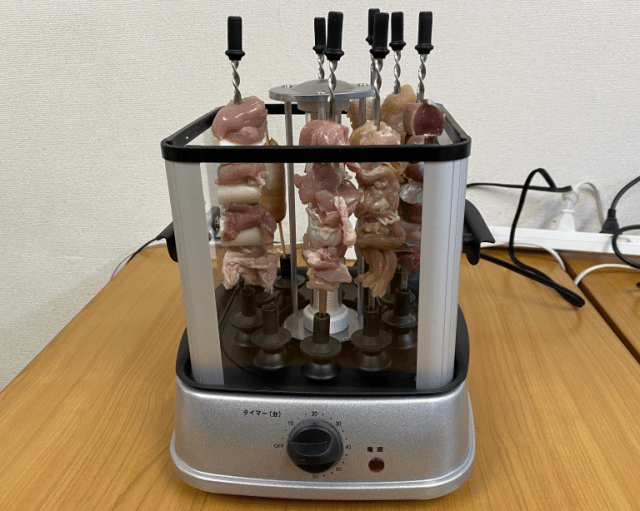
If you’re working from your home office, isn’t is also time to start eating at your home pub?
After putting in a long, hard day of work, there’s nothing that lifts the spirit quite like stopping by a pub for a cold one and couple of yakitori chicken skewers. Of course, your regular after-work pub might now be inaccessible due to quarantine and social distancing.
But fear not, because Japanese technology (i.e. wacky gadget) company Thanko has a solution with its Homemade Yakitori Maker 2!
Yes, we’re honestly extremely upset at ourselves for not having known about the existence of a Homemade Yakitori Maker 1, but we’re totally on board for this home-cooking appliance sequel.
The Homemade Yakitori Maker 2 sells for 6,280 yen (US$59) here through Thanko’s online shop. When our box arrived, the first thing we did was open it up and lay out all the parts.
The core unit is a heat-cooking shaft with slots in its base to insert metal skewers, and there’s also a removable black base cover to catch any drippings and make for easy cleaning. Finally, there’s a sturdy glass shield that goes around the outside of whatever you’re cooking. You’ll notice there’s no top to the cover, though, but that’s okay because the Homemade Yakitori Maker 2 promises to let you do all the indoor skewer-cooking you want without producing any smoke.
Since the machine lets you cook 10 different skewers simultaneously, we decided to branch out from just chicken and also picked up some bacon, sausages, and negi (green onion).
The skewers’ tips are very sharp, so sticking the ingredients on them was no problem. However, you’ll want to keep the meat toward the center of the rod, not at either end, for reasons we’ll explain later on.
▼ Also, since you’re supposed to eat yakitori straight off the stick, cutting the meat into bite-sized pieces is the way to go.
Once you’ve done all your slicing and sticking, it’s time to insert the skewers into the base of the Homemade Yakitori Maker 2. Since the skewers slide in pointy side-down, you’ll want to leave a little buffer space around their tips.
Now we were ready to start cooking, so we turned on the machine by twisting the dial at its base, which also functions as a timer for cooking times up to one hour. As the machine powered up, its core began to glow with orange light…
…but the big surprise came when…
…the skewers began rotating on their own!
After about 10 minutes, the meat’s outer layer began to turn an enticing golden brown, and the occasional popping of a pocket of oil enticed us all the more. Just as promised, though, the Homemade Yakitori Maker 2 makes no smoke at all.
After 30 minutes, our yakitori were ready to eat. Well, more accurately, most of our yakitori were ready to eat. Remember how we said it’s important to arrange your pre-cooking skewers with most of their meat in the center? That’s because if you give in to your gluttony like we did and cram meat all the way to the utmost top section of the skewers, it’ll be too far away from the unit’s core to get enough heat to cook.
But as long as you refrain from imitating our insufficient inability to control our desires (something that’s always good advice, frankly), in half an hour or so you’ll be ready to eat!
▼ A negima yakitori skewer, alternating pieces of chicken and green onion
▼ You can even cook wings with the Homemade Yakitori Maker 2.
Yakitori seasoning is a simple thing, with the traditional choices being salt or teriyaki sauce.
Flavor-wise, our batch of Homemade Yakitori Maker 2 skewers tasted as good as what you’d get in a standard Tokyo pub, and we were so totally satisfied that before we knew it, we’d eaten them all.
Like we mentioned above, the whole thing breaks down into individual parts for easy washing, so now we’re ready to repeat he process all over again, perhaps with a side of fluffy white grains from our one-person portable rice cooker or some extra protein from our smokeless yakiniku grill.
Photos: ©SoraNews24
● Want to hear about SoraNews24’s latest articles as soon as they’re published? Follow us on Facebook and Twitter!
[ Read in Japanese ]



















 We create a Japanese izakaya pub at home with an amazing all-in-one kitchen gadget
We create a Japanese izakaya pub at home with an amazing all-in-one kitchen gadget Get ‘em while they’re cold! Tokyo restaurant has chilled chicken skewers in collagen blocks
Get ‘em while they’re cold! Tokyo restaurant has chilled chicken skewers in collagen blocks The strange part of Japan where “grilled chicken” doesn’t always mean “chicken”
The strange part of Japan where “grilled chicken” doesn’t always mean “chicken” Kyoto yakitori restaurant earns Michelin rating with one of the best value-for-money deals in Japan
Kyoto yakitori restaurant earns Michelin rating with one of the best value-for-money deals in Japan The Zenyaren restaurant in Otemachi offers water jelly for the summer … with chicken inside it!
The Zenyaren restaurant in Otemachi offers water jelly for the summer … with chicken inside it! New Tokyo restaurant charges higher prices to foreign tourists than Japanese locals
New Tokyo restaurant charges higher prices to foreign tourists than Japanese locals Studio Ghibli releases new mug and tumbler collection featuring Jiji and Totoro
Studio Ghibli releases new mug and tumbler collection featuring Jiji and Totoro Tokyo’s famous Lost in Translation hotel is closed
Tokyo’s famous Lost in Translation hotel is closed Japanese hot spring inn lets you spend night for under US$1 if you do something special in return
Japanese hot spring inn lets you spend night for under US$1 if you do something special in return Tokyo DisneySea’s new Fantasy Springs area reveals the beauty of Rapunzel’s Forest
Tokyo DisneySea’s new Fantasy Springs area reveals the beauty of Rapunzel’s Forest Foreign shoppers in Akihabara tip us off to an awesome souvenir idea: DIY Paper Theater kit【Pics】
Foreign shoppers in Akihabara tip us off to an awesome souvenir idea: DIY Paper Theater kit【Pics】 Tokyo tortilla restaurant is worth visiting whether you love or hate traditional Mexican cuisine
Tokyo tortilla restaurant is worth visiting whether you love or hate traditional Mexican cuisine To combat declining birth rate, Japan to begin offering “Breeding Visas” to foreigners
To combat declining birth rate, Japan to begin offering “Breeding Visas” to foreigners Godzilla leather wallet will make you feel like the King of the Monsters and lord of fashion
Godzilla leather wallet will make you feel like the King of the Monsters and lord of fashion Foreigner’s request for help in Tokyo makes us sad for the state of society
Foreigner’s request for help in Tokyo makes us sad for the state of society “Mt. Fuji convenience store” issues apology for bad tourist manners, adds multilingual signs
“Mt. Fuji convenience store” issues apology for bad tourist manners, adds multilingual signs How to make a secret rice bowl at Ichiran ramen
How to make a secret rice bowl at Ichiran ramen FUK COFFEE?!? Japanese cafe has a perfectly innocent reason for its startling-looking name
FUK COFFEE?!? Japanese cafe has a perfectly innocent reason for its startling-looking name Studio Ghibli unveils new goods that tip the hat to The Cat Returns
Studio Ghibli unveils new goods that tip the hat to The Cat Returns McDonald’s Japan’s new pancake pie is a taste sensation
McDonald’s Japan’s new pancake pie is a taste sensation Japan has nearly 4 million abandoned homes, but where and why?
Japan has nearly 4 million abandoned homes, but where and why? Tokyo sweets store sells beautiful soft serve ice creams that look like works of art
Tokyo sweets store sells beautiful soft serve ice creams that look like works of art Bad tourist manners at Mt Fuji Lawson photo spot prompts Japanese town to block view with screens
Bad tourist manners at Mt Fuji Lawson photo spot prompts Japanese town to block view with screens Two things to do, and two things not to do, when leaving a traditional Japanese inn
Two things to do, and two things not to do, when leaving a traditional Japanese inn This is Japan’s, and the world’s, first capsule hotel, and you can still stay there
This is Japan’s, and the world’s, first capsule hotel, and you can still stay there McDonald’s new Happy Meals offer up cute and practical Sanrio lifestyle goods
McDonald’s new Happy Meals offer up cute and practical Sanrio lifestyle goods Japanese ramen restaurants under pressure from new yen banknotes
Japanese ramen restaurants under pressure from new yen banknotes All-you-can-drink Starbucks and amazing views part of Tokyo’s new 170 meter-high sky lounge
All-you-can-drink Starbucks and amazing views part of Tokyo’s new 170 meter-high sky lounge More foreign tourists than ever before in history visited Japan last month
More foreign tourists than ever before in history visited Japan last month Disney princesses get official manga makeovers for Manga Princess Cafe opening in Tokyo
Disney princesses get official manga makeovers for Manga Princess Cafe opening in Tokyo French Fries Bread in Tokyo’s Shibuya becomes a hit on social media
French Fries Bread in Tokyo’s Shibuya becomes a hit on social media Sales of Japan’s most convenient train ticket/shopping payment cards suspended indefinitely
Sales of Japan’s most convenient train ticket/shopping payment cards suspended indefinitely Sold-out Studio Ghibli desktop humidifiers are back so Totoro can help you through the dry season
Sold-out Studio Ghibli desktop humidifiers are back so Totoro can help you through the dry season Japanese government to make first change to romanization spelling rules since the 1950s
Japanese government to make first change to romanization spelling rules since the 1950s Ghibli founders Toshio Suzuki and Hayao Miyazaki contribute to Japanese whisky Totoro label design
Ghibli founders Toshio Suzuki and Hayao Miyazaki contribute to Japanese whisky Totoro label design Tokyo’s most famous Starbucks is closed
Tokyo’s most famous Starbucks is closed Doraemon found buried at sea as scene from 1993 anime becomes real life【Photos】
Doraemon found buried at sea as scene from 1993 anime becomes real life【Photos】 One Piece characters’ nationalities revealed, but fans have mixed opinions
One Piece characters’ nationalities revealed, but fans have mixed opinions We asked a Uniqlo employee what four things we should buy and their suggestions didn’t disappoint
We asked a Uniqlo employee what four things we should buy and their suggestions didn’t disappoint Shibuya unveils two new local ramen dishes themed after famously loyal local dog Hachiko
Shibuya unveils two new local ramen dishes themed after famously loyal local dog Hachiko You can buy, and eat, a grilled sparrow on the streets of Kyoto, so we did【Taste test】
You can buy, and eat, a grilled sparrow on the streets of Kyoto, so we did【Taste test】 Japanese restaurant chain causes a stir with foreigners online, but is it any good?
Japanese restaurant chain causes a stir with foreigners online, but is it any good? Shinjuku izakaya’s all-you-can-eat-and-drink plan is one of Tokyo’s best secret cheap eats
Shinjuku izakaya’s all-you-can-eat-and-drink plan is one of Tokyo’s best secret cheap eats Got a beef with Japan’s Christmas shortcakes? Then try one made out of chicken
Got a beef with Japan’s Christmas shortcakes? Then try one made out of chicken This pork-wrapped Japanese dessert recipe is outside the box and out of this world【Recipe】
This pork-wrapped Japanese dessert recipe is outside the box and out of this world【Recipe】 Beautiful hydrangea pattern adds a touch of elegance to traditional Japanese fish cake
Beautiful hydrangea pattern adds a touch of elegance to traditional Japanese fish cake Is Japan’s highest-ranking unagi restaurant worth the six-month wait for a table? We find out
Is Japan’s highest-ranking unagi restaurant worth the six-month wait for a table? We find out Tokyo pub lets you grill traditional Japanese dessert right at your table in all-you-can-eat deal
Tokyo pub lets you grill traditional Japanese dessert right at your table in all-you-can-eat deal We try European Cup Noodle Soba flavors to see which ones come out on top 【Taste test】
We try European Cup Noodle Soba flavors to see which ones come out on top 【Taste test】 We bought a sausage egg roll maker because of social media, but was it worth it?
We bought a sausage egg roll maker because of social media, but was it worth it? Ever wanted a sumo sandwich? New baked goods line gets stamp of approval from wrestlers in Japan
Ever wanted a sumo sandwich? New baked goods line gets stamp of approval from wrestlers in Japan Yoshinoya has a semi-secret chicken bowl you won’t find anywhere on its website【Taste test】
Yoshinoya has a semi-secret chicken bowl you won’t find anywhere on its website【Taste test】 Japanese beef bowl chain Yoshinoya releases new canned, ready-to-eat rice bowls 【Taste Test】
Japanese beef bowl chain Yoshinoya releases new canned, ready-to-eat rice bowls 【Taste Test】 Golden Japanese toilet appears at “multi-millionaire” izakaya in Tokyo
Golden Japanese toilet appears at “multi-millionaire” izakaya in Tokyo Second anime cafe based on films of Summer Wars’ Mamoru Hosoda now open in Japan
Second anime cafe based on films of Summer Wars’ Mamoru Hosoda now open in Japan
Leave a Reply